(为小屏幕设备进优化)
Downtown, miscellaneous pictures - Pécs, 匈牙利
當你點擊:
点击图片
-

The Barbican (or "Barbakán" in Hungarian) bastion on the castle wall, and the Episcopal Palace
拍摄日期:20092009
创建者:Robert Németh
相机型号:Konica Minolta Dimage A200
Pécs, 匈牙利
-
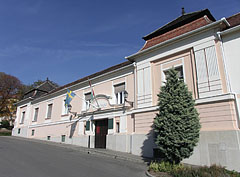
"Pezsgőház" or "Champagne House", the building of the former Littke champagne factory
拍摄日期:20092009
创建者:Robert Németh
相机型号:Konica Minolta Dimage A200
Pécs, 匈牙利
-
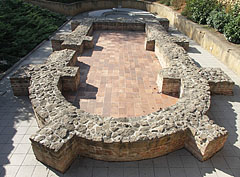
Wall remains of the chapel, viewed from its apse, over the Early Christian Burial Chamber I (Peter-Paul chamber or crypt)
This chamber was discovered in 1782.
拍摄日期:20092009
创建者:Robert Németh
相机型号:Konica Minolta Dimage A200
Pécs, 匈牙利
-
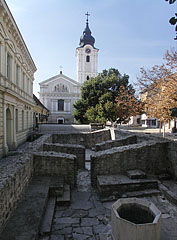
The ruins of turkish Memi Pasa's Baths, beside the Franciscan church
拍摄日期:20092009
创建者:Robert Németh
相机型号:Konica Minolta Dimage A200
Pécs, 匈牙利
-
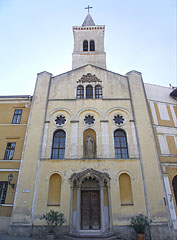
Facade of the Roman Catholic Priory Church of Our Lady, with a Virgin Mary Statue above the door
Created by Mihály Bartalits in 1850
拍摄日期:20092009
创建者:Robert Németh
相机型号:Konica Minolta Dimage A200
Pécs, 匈牙利
-
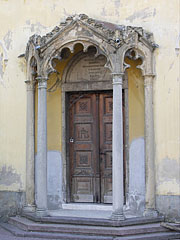
The door of the Priory Church or Convent Church of Our Lady ("Miasszonyunk-zárdatemlom")
Formerly the baroque style Roman Catholic Church of Our Lady ("Nagyboldogasszony-templom") stood on this place, that was built in 1727.
拍摄日期:20092009
创建者:Robert Németh
相机型号:Konica Minolta Dimage A200
Pécs, 匈牙利
-
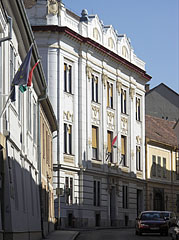
Apáca Street
拍摄日期:20092009
创建者:Robert Németh
相机型号:Konica Minolta Dimage A200
Pécs, 匈牙利
-
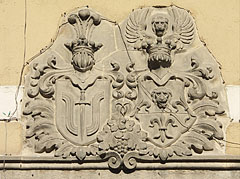
Carved limestone crests over the door of the County Library
拍摄日期:20092009
创建者:Robert Németh
相机型号:Konica Minolta Dimage A200
Pécs, 匈牙利
-
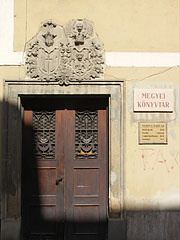
The door of the County Library was built in the late 18th century, above there are some carved crests
There are 4th-century Roman tombs in its courtyard.
拍摄日期:20092009
创建者:Robert Németh
相机型号:Konica Minolta Dimage A200
Pécs, 匈牙利
-

Street sign on a wall
拍摄日期:20092009
创建者:Robert Németh
相机型号:Konica Minolta Dimage A200
Pécs, 匈牙利
-
A building of the Hungarian State Treasury in Pécs
拍摄日期:20092009
创建者:Robert Németh
相机型号:Konica Minolta Dimage A200
Pécs, 匈牙利
A building of the Hungarian State Treasury in Pécs - Pécs, 匈牙利 -
A building of the Hungarian State Treasury in Pécs
拍摄日期:20092009
创建者:Robert Németh
相机型号:Konica Minolta Dimage A200
Pécs, 匈牙利
A building of the Hungarian State Treasury in Pécs - Pécs, 匈牙利 -
拍摄日期:20092009
创建者:Robert Németh
相机型号:Konica Minolta Dimage A200
Pécs, 匈牙利
- Pécs, 匈牙利 -
The romantic style Priory Church of Our Lady
The current church was built between 1852 and 1854.
拍摄日期:20092009
创建者:Robert Németh
相机型号:Konica Minolta Dimage A200
Pécs, 匈牙利
The romantic style Priory Church of Our Lady - Pécs, 匈牙利 -
拍摄日期:20092009
创建者:Robert Németh
相机型号:Konica Minolta Dimage A200
Pécs, 匈牙利
- Pécs, 匈牙利 -
拍摄日期:20092009
创建者:Robert Németh
相机型号:Konica Minolta Dimage A200
Pécs, 匈牙利
- Pécs, 匈牙利 -
拍摄日期:20092009
创建者:Robert Németh
相机型号:Konica Minolta Dimage A200
Pécs, 匈牙利
- Pécs, 匈牙利 -
拍摄日期:20092009
创建者:Robert Németh
相机型号:Konica Minolta Dimage A200
Pécs, 匈牙利
- Pécs, 匈牙利 -
拍摄日期:20092009
创建者:Robert Németh
相机型号:Konica Minolta Dimage A200
Pécs, 匈牙利
- Pécs, 匈牙利 -
拍摄日期:20092009
创建者:Robert Németh
相机型号:Konica Minolta Dimage A200
Pécs, 匈牙利
- Pécs, 匈牙利 -
拍摄日期:20092009
创建者:Robert Németh
相机型号:Konica Minolta Dimage A200
Pécs, 匈牙利
- Pécs, 匈牙利 -
拍摄日期:20092009
创建者:Robert Németh
相机型号:Konica Minolta Dimage A200
Pécs, 匈牙利
- Pécs, 匈牙利 -
拍摄日期:20092009
创建者:Robert Németh
相机型号:Konica Minolta Dimage A200
Pécs, 匈牙利
- Pécs, 匈牙利 -
"Pezsgőház" or "Champagne House", the building of the former Littke champagne factory
拍摄日期:20092009
创建者:Robert Németh
相机型号:Konica Minolta Dimage A200
Pécs, 匈牙利
"Pezsgőház" or "Champagne House", the building of the former Littke champagne factory - Pécs, 匈牙利 -
拍摄日期:20092009
创建者:Robert Németh
相机型号:Konica Minolta Dimage A200
Pécs, 匈牙利
- Pécs, 匈牙利 -
Statue of Tivadar Csontváry Kosztka Hungarian painter, in front of the Csontváry Museum
The statue was created by Jenő Kerényi in 1962.
拍摄日期:20092009
创建者:Robert Németh
相机型号:Konica Minolta Dimage A200
Pécs, 匈牙利
Statue of Tivadar Csontváry Kosztka Hungarian painter, in front of the Csontváry Museum - Pécs, 匈牙利 -
拍摄日期:20092009
创建者:Robert Németh
相机型号:Konica Minolta Dimage A200
Pécs, 匈牙利
- Pécs, 匈牙利 -
拍摄日期:20092009
创建者:Robert Németh
相机型号:Konica Minolta Dimage A200
Pécs, 匈牙利
- Pécs, 匈牙利 -
拍摄日期:20092009
创建者:Robert Németh
相机型号:Konica Minolta Dimage A200
Pécs, 匈牙利
- Pécs, 匈牙利 -
拍摄日期:20092009
创建者:Robert Németh
相机型号:Konica Minolta Dimage A200
Pécs, 匈牙利
- Pécs, 匈牙利 -
拍摄日期:20092009
创建者:Robert Németh
相机型号:Konica Minolta Dimage A200
Pécs, 匈牙利
- Pécs, 匈牙利 -
拍摄日期:20092009
创建者:Robert Németh
相机型号:Konica Minolta Dimage A200
Pécs, 匈牙利
- Pécs, 匈牙利 -
拍摄日期:20092009
创建者:Robert Németh
相机型号:Konica Minolta Dimage A200
Pécs, 匈牙利
- Pécs, 匈牙利 -
Love padlocks on the wall
拍摄日期:20092009
创建者:Robert Németh
相机型号:Konica Minolta Dimage A200
Pécs, 匈牙利
Love padlocks on the wall - Pécs, 匈牙利 -
Love locks (lovers' padlocks)
拍摄日期:20092009
创建者:Robert Németh
相机型号:Konica Minolta Dimage A200
Pécs, 匈牙利
Love locks (lovers' padlocks) - Pécs, 匈牙利 -
A corner house
拍摄日期:20092009
创建者:Robert Németh
相机型号:Konica Minolta Dimage A200
Pécs, 匈牙利
A corner house - Pécs, 匈牙利 -
Love padlocks
拍摄日期:20092009
创建者:Robert Németh
相机型号:Konica Minolta Dimage A200
Pécs, 匈牙利
Love padlocks - Pécs, 匈牙利 -
Love padlocks on the so-called "Lovers' Wall, the second"
拍摄日期:20092009
创建者:Robert Németh
相机型号:Konica Minolta Dimage A200
Pécs, 匈牙利
Love padlocks on the so-called "Lovers' Wall, the second" - Pécs, 匈牙利 -
Lovers' padlocks
拍摄日期:20092009
创建者:Robert Németh
相机型号:Konica Minolta Dimage A200
Pécs, 匈牙利
Lovers' padlocks - Pécs, 匈牙利 -
Janus Pannonius Street, the "Lovers' Wall" with the padlocks can be shown on the left
拍摄日期:20092009
创建者:Robert Németh
相机型号:Konica Minolta Dimage A200
Pécs, 匈牙利
Janus Pannonius Street, the "Lovers' Wall" with the padlocks can be shown on the left - Pécs, 匈牙利 -
Barbican ("Barbakán" bastion or tower)
拍摄日期:20092009
创建者:Robert Németh
相机型号:Konica Minolta Dimage A200
Pécs, 匈牙利
Barbican ("Barbakán" bastion or tower) - Pécs, 匈牙利 -
The gate of the Barbican with the drawbridge
拍摄日期:20092009
创建者:Robert Németh
相机型号:Konica Minolta Dimage A200
Pécs, 匈牙利
The gate of the Barbican with the drawbridge - Pécs, 匈牙利 -
Glimpse to the Bishop's Palace from the Barbican
拍摄日期:20092009
创建者:Robert Németh
相机型号:Konica Minolta Dimage A200
Pécs, 匈牙利
Glimpse to the Bishop's Palace from the Barbican - Pécs, 匈牙利 -
Barbican ("Barbakán")
拍摄日期:20092009
创建者:Robert Németh
相机型号:Konica Minolta Dimage A200
Pécs, 匈牙利
Barbican ("Barbakán") - Pécs, 匈牙利 -
Barbican ("Barbakán")
拍摄日期:20092009
创建者:Robert Németh
相机型号:Konica Minolta Dimage A200
Pécs, 匈牙利
Barbican ("Barbakán") - Pécs, 匈牙利 -
A creeper plant (Parthenocissus) covered stone gate, with the Barbakán bastion (the Barbican)
拍摄日期:20092009
创建者:Robert Németh
相机型号:Konica Minolta Dimage A200
Pécs, 匈牙利
A creeper plant (Parthenocissus) covered stone gate, with the Barbakán bastion (the Barbican) - Pécs, 匈牙利 -
Remains of the former castle wall near the Bishop's Palace
拍摄日期:20092009
创建者:Robert Németh
相机型号:Konica Minolta Dimage A200
Pécs, 匈牙利
Remains of the former castle wall near the Bishop's Palace - Pécs, 匈牙利 -
Bronze statue of Janus Pannoniues, the 15th-century Hungarian humanist poet and bishop of Pécs
Created by Miklós Borsos in 1972
拍摄日期:20092009
创建者:Robert Németh
相机型号:Konica Minolta Dimage A200
Pécs, 匈牙利
Bronze statue of Janus Pannoniues, the 15th-century Hungarian humanist poet and bishop of Pécs - Pécs, 匈牙利 -
Statue of Janus Pannonius Hungarian humanist poet, in front of the Barbican and the Episcopal Palace
The statue was created by Borsos Miklós in 1972.
拍摄日期:20092009
创建者:Robert Németh
相机型号:Konica Minolta Dimage A200
Pécs, 匈牙利
Statue of Janus Pannonius Hungarian humanist poet, in front of the Barbican and the Episcopal Palace - Pécs, 匈牙利 -
The yellow Bishop's Palace (or Episcopal Palace, in Hungarian: "Püspöki Palota") from the garden
拍摄日期:20092009
创建者:Robert Németh
相机型号:Konica Minolta Dimage A200
Pécs, 匈牙利
The yellow Bishop's Palace (or Episcopal Palace, in Hungarian: "Püspöki Palota") from the garden - Pécs, 匈牙利 -
Tower of the Bishop's Palace (or Episcopal Palace in other words)
拍摄日期:20092009
创建者:Robert Németh
相机型号:Konica Minolta Dimage A200
Pécs, 匈牙利
Tower of the Bishop's Palace (or Episcopal Palace in other words) - Pécs, 匈牙利 -
The Bishop's Palace and the castle wall
拍摄日期:20092009
创建者:Robert Németh
相机型号:Konica Minolta Dimage A200
Pécs, 匈牙利
The Bishop's Palace and the castle wall - Pécs, 匈牙利 -
The metal sculpture of Ferenc Liszt Hungarian composer looks around from the balcony
The stainless chromium steel statue was created by Imre Varga in 1983.
拍摄日期:20092009
创建者:Robert Németh
相机型号:Konica Minolta Dimage A200
Pécs, 匈牙利
The metal sculpture of Ferenc Liszt Hungarian composer looks around from the balcony - Pécs, 匈牙利 -
Tower of the Episcopal Palace (or Bishop's Palace)
拍摄日期:20092009
创建者:Robert Németh
相机型号:Konica Minolta Dimage A200
Pécs, 匈牙利
Tower of the Episcopal Palace (or Bishop's Palace) - Pécs, 匈牙利 -
Calstle wall remains and the Bishop's Palace
拍摄日期:20092009
创建者:Robert Németh
相机型号:Konica Minolta Dimage A200
Pécs, 匈牙利
Calstle wall remains and the Bishop's Palace - Pécs, 匈牙利 -
Barbican ("Barbakán" bastion or tower)
拍摄日期:20092009
创建者:Robert Németh
相机型号:Konica Minolta Dimage A200
Pécs, 匈牙利
Barbican ("Barbakán" bastion or tower) - Pécs, 匈牙利 -
拍摄日期:20092009
创建者:Robert Németh
相机型号:Konica Minolta Dimage A200
Pécs, 匈牙利
- Pécs, 匈牙利 -
Loophole or porthole on the Barbican, shaped like a cross-bearing orb (globus cruciger)
拍摄日期:20092009
创建者:Robert Németh
相机型号:Konica Minolta Dimage A200
Pécs, 匈牙利
Loophole or porthole on the Barbican, shaped like a cross-bearing orb (globus cruciger) - Pécs, 匈牙利 -
The circular-shaped Barbican ("Barbakán") bastion with a small drawbridge and the flag of Hungary
拍摄日期:20092009
创建者:Robert Németh
相机型号:Konica Minolta Dimage A200
Pécs, 匈牙利
The circular-shaped Barbican ("Barbakán") bastion with a small drawbridge and the flag of Hungary - Pécs, 匈牙利 -
The TV tower of Pécs and the Mecsek Mountains from the inner city
The tower was inaugurated in 1973.
拍摄日期:20092009
创建者:Robert Németh
相机型号:Konica Minolta Dimage A200
Pécs, 匈牙利
The TV tower of Pécs and the Mecsek Mountains from the inner city - Pécs, 匈牙利 -
The TV tower of Pécs, on the top of the Misina Mountain in the Mecsek Mountain Range
The tower is 197 meters tall, as well as the mountain where it stands is 535 meters above the ocean level.
拍摄日期:20092009
创建者:Robert Németh
相机型号:Konica Minolta Dimage A200
Pécs, 匈牙利
The TV tower of Pécs, on the top of the Misina Mountain in the Mecsek Mountain Range - Pécs, 匈牙利 -
The romantic style synagogue of Pécs
It was built in 1869, architects: Frigyes Feszl, Károly Gerster and Lipót Kauser.
拍摄日期:20092009
创建者:Robert Németh
相机型号:Konica Minolta Dimage A200
Pécs, 匈牙利
The romantic style synagogue of Pécs - Pécs, 匈牙利 -
The steeple (tower) of the Franciscan church
拍摄日期:20092009
创建者:Robert Németh
相机型号:Konica Minolta Dimage A200
Pécs, 匈牙利
The steeple (tower) of the Franciscan church - Pécs, 匈牙利 -
The Memi Pasa's Turkish Bath from the Ottoman period
It was discovered in 1979.
拍摄日期:20092009
创建者:Robert Németh
相机型号:Konica Minolta Dimage A200
Pécs, 匈牙利
The Memi Pasa's Turkish Bath from the Ottoman period - Pécs, 匈牙利 -
The Franciscan Church of Pécs (officially called Parish Church of St. Francis of Assisi)
It was built between 1718 and 1760.
拍摄日期:20092009
创建者:Robert Németh
相机型号:Konica Minolta Dimage A200
Pécs, 匈牙利
The Franciscan Church of Pécs (officially called Parish Church of St. Francis of Assisi) - Pécs, 匈牙利 -
Memi Pasa's Baths from the time of the Ottoman (turkish) rule in Hungary
拍摄日期:20092009
创建者:Robert Németh
相机型号:Konica Minolta Dimage A200
Pécs, 匈牙利
Memi Pasa's Baths from the time of the Ottoman (turkish) rule in Hungary - Pécs, 匈牙利 -
The Franciscan Church of Pécs (Parish Church of St. Francis of Assisi or simply the Friars' church)
拍摄日期:20092009
创建者:Robert Németh
相机型号:Konica Minolta Dimage A200
Pécs, 匈牙利
The Franciscan Church of Pécs (Parish Church of St. Francis of Assisi or simply the Friars' church) - Pécs, 匈牙利 -
Wall painting on theFranciscan church
拍摄日期:20092009
创建者:Robert Németh
相机型号:Konica Minolta Dimage A200
Pécs, 匈牙利
Wall painting on theFranciscan church - Pécs, 匈牙利 -
A fresco on the outer wall of the Franciscan church
Painted by Ernő Gebauer in 1926
拍摄日期:20092009
创建者:Robert Németh
相机型号:Konica Minolta Dimage A200
Pécs, 匈牙利
A fresco on the outer wall of the Franciscan church - Pécs, 匈牙利 -
Tower and steeple of the Franciscan Church of Pécs (the Friars' church)
拍摄日期:20092009
创建者:Robert Németh
相机型号:Konica Minolta Dimage A200
Pécs, 匈牙利
Tower and steeple of the Franciscan Church of Pécs (the Friars' church) - Pécs, 匈牙利
点击图片
特性,特征
位置:
GPS坐标的: 纬度 46°4'40",经度 18°13'17" (N46 4.67 - E18 13.28)
信息,短篇小说,有趣的事实
 "Pezsgőház" or "Champagne House", the building of the former Littke champagne factory
"Pezsgőház" or "Champagne House", the building of the former Littke champagne factory
The Littke Champagne Factory was founded by the Polish-born Lőrinc Littke in 1859, it was the first champagne production facility within the territory of the present-day Hungary. The first champagne factory in the area of the historical Hungary (Kingdom of Hungary, until 1920) was opened in Pozsony (today Bratislava, Slovakia) in 1825, founded by János Fischer wine and colonial produce merchant and dr. Mihály Schönbauer physician, then in 1877 it was acquired by the Austrian-born Johann E. Hubert. The Hungarian word for champagne is "pezsgő", it means bubbly or sparkling and probably created by Count István Széchenyi, who mentioned it first in his writing called "Hitel" ("Credit") in 1830. Formerly the French "champagnier" or "champagne" words were used for the sparkling wine in Hungary.
The headquarters of Lőrinc Littke's factory was in Pécs, in the so-called "Pezsgőház" (literally "Champagne House") building on the Szent István Square. The Littke Champagne Factory was operating until the end of World War II, then in 1949 the state monopolized it and the production of champagne in Pécs was virtually ceased for some time. The champagne production was restarted in the Littke Winery only in 1966, under Pannonvin Champagne Factory name an as a part of the "Állami Pincegazdaság" (approx. "State Winery"). After more change in the name and the owner the former Littke Winery is now operated by a company which engages in both viticulture and winery.
 "Pezsgőház" or "Champagne House", the building of the former Littke champagne factory
"Pezsgőház" or "Champagne House", the building of the former Littke champagne factory
For 90 years the "Pezsgőház" ("Champagne House") in Pécs was the home of one of the first champagne production facility in Hungary, the Littke Champagne Factory. Below it there is one of the longest cellar systems of Pécs. It is 2 km long and has five levels beneath the building, the lowest is 12 meters under the street level. The cellars have an average temperature of between 12 and 14 °C and they can be visited. There is a champagne museum here, as well as a 200-hectoliter-capacity giant oak barrel and of course many other curiosities. The building on the Szent István Square is today already more than 150 years old, among others there is a restaurant (Pezsgőház Restaurant) within its walls, since 1999.
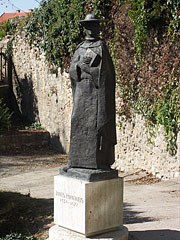 Bronze statue of Janus Pannoniues, the 15th-century Hungarian humanist poet and bishop of Pécs
Bronze statue of Janus Pannoniues, the 15th-century Hungarian humanist poet and bishop of Pécs
Created by Miklós Borsos in 1972
Janus Pannonius (born as János Csezmiczei, 1434-1472) was the bishop of Pécs and the first Hungarian humanist poet who was known also by his name throughout Europe. He was born in a Croato-Hungarian probably as Croatian under the name of Ivan Česmički, in Chezmicze (present-day Čazma), Croatia. He lived in the age of King Matthias Corvinus, in the 15th-century renaissance Hungary. He studied in Nagyvárad (in Romanian Oradea, today in Romania) and his uncle Archbishop János Vitéz was his mentor. By the way, János Vitéz was the initiator of the Hungarian humanism, and also one of the educators of Matthias Hunyadi, the later King Matthias I of Hungary.
In its time the poetry of Janus Pannonius was a novelty, because instead of the religious ideas now it put the emphasis on the humanism and the renaissance attitude to life (desire for peace, life-loving, admiration of the nature, appreciation of science and culture, etc.). The style of his poems is based on the Italian humanism.
There is a full-figure statue of the poet in the garden of the Bishop's Palace ("Püspöki palota") in Pécs. It was created by Miklós Borsos, who entrusted the face of the poet to his imagination, because there's no any survived authentic portrait of Janus Pannonius. Allegedly this is why the statue wears a wide-brimmed Italian hat, to overshadow the face and also refer to its mysteriousness. The bronze artwork was inaugurated in 1972 for the 500th anniversary of the poet's death. In addition, an almond tree was planted beside the statue to refer his love of nature and also to one of his nice verse.
Pécs, 匈牙利 - 更多的照片画廊:
您可能也有兴趣(相关网页):
目的地在旅遊指南:
Pécs(225张照片 + 3全景图像)
Mecsek Mountains(304张照片 + 3全景图像)
Baranya megye (county)(857张照片 + 4全景图像)
Southern Transdanubia (Dél-Dunántúl)(1,597张照片 + 8全景图像)
匈牙利(27,287张照片 + 163全景图像)
并且还:
(在这里:Mecsek Mountains)
Abaliget(10张照片)
Magyaregregy(69张照片)
Orfű
Püspökszentlászló
这里每全景照片:
Pécs(3张照片)
Baranya megye (county)(4张照片)
Southern Transdanubia (Dél-Dunántúl)(8张照片)
匈牙利(163张照片)
欧洲(165张照片)
每一个正常的照片在这里:
Pécs(225张照片 / 4画廊)
Mecsek Mountains(304张照片 / 6画廊)
Baranya megye (county)(857张照片 / 17画廊)
Southern Transdanubia (Dél-Dunántúl)(1,597张照片 / 32画廊)
匈牙利(27,287张照片 / 462画廊)
欧洲(30,494张照片 / 523画廊)
与你的朋友分享!
等等






